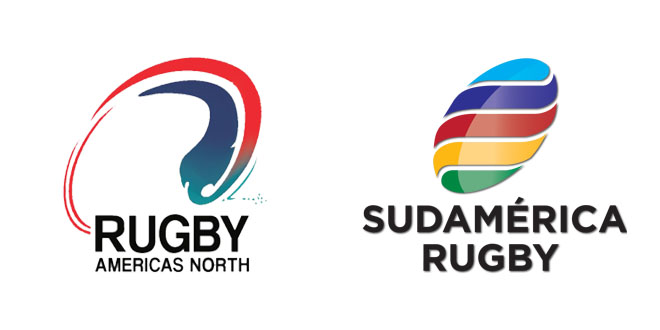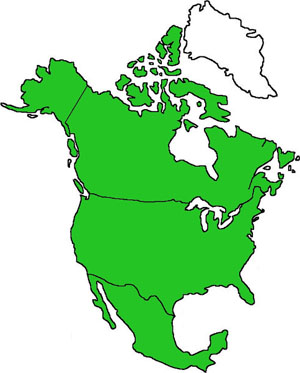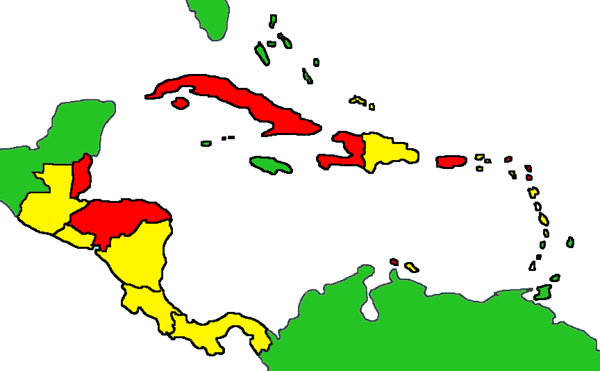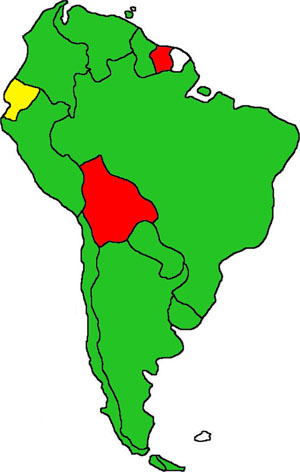Rugby is experiencing an explosion of participation and popularity throughout the Americas, one that is expected to see considerable growth from the Olympics. This is true both in terms of established rugby countries and those in their infancy. To better understand the current situation it is useful to define a tiered classification system of Americas rugby similar to that utilized by World Rugby.
Global and Americas Terms
According to World Rugby characterization the Americas, presently, has Argentina as a Tier 1 rugby nation, Canada and the USA as Tier 2 nations and all others as Tier 3.
The definitions adhered to by the sport’s global governing body are highly explanatory for Rugby World Cups, both in terms of participants and results. In Rugby World Cup 2015 the four sides who were winless were Canada, Namibia Uruguay, and the USA. Of them two were the only two Tier 3 nations involved.
Back in Rugby World Cup 2011 it was identical. The four winless teams on that occasion were Japan, Namibia, Romania, and Russia. Again, Japan and Romania are considered Tier 2 by World Rugby while Namibia and Russia are Tier 3.
Ongoing work within certain countries is actively building towards some completing the transition to obtain a higher status. Japan is a well documented case in point while Canada, Georgia, Romania and the USA have their own road maps to follow.
Making the leap from Tier 3 to Tier 2, meanwhile, is Uruguay. The South American republic has established a national high performance system and has been highly successful in gaining a significantly improved international program. The URU is even on record as stating that it has applied for Tier 2 status.
Further down signs of significant progress are highly visible in a number of countries including Brazil, Colombia, Mexico, and Paraguay. None of them, however, will be able to achieve Tier 2 status for many years. Within the Americas, though, all ought to be classified in the same bracket as the continent’s four participants in Rugby World Cup 2015.
Americas Tier 1
Equals need not be interpreted as abilities on the field or their existing status in global terms. Rather they ought to be viewed as meriting Tier 1 status in the Americas due to them having both full World Rugby membership status and regional membership with Rugby Americas North or Sudamérica Rugby.
All countries in the Americas who are full World Rugby members are also ratified members of either Rugby Americas North or Sudamérica Rugby. This provides them with a superior organizational structure than others. Take Peru and Ecuador as instances with the former being a World Rugby member and the later a Sudamérica Rugby member yet to obtain World Rugby status.
This distinction is highly useful to better understand Americas Rugby both at the present point in time and in moving forward. It will act as an important guide for long-term developments such as the establishment of a second division to the Americas Rugby Championship.
As a starting point the good news is that the number of Americas Tier 1 unions is large and it is growing steadily. The following table lists all those who fall into the category of Americas Tier 1 nations.
| Country | Regional Body | WR Membership |
| Argentina | Sudamérica Rugby | 1987 |
| Bahamas | Americas Rugby North | 1994 |
| Barbados | Americas Rugby North | 1995 |
| Bermuda | Americas Rugby North | 1992 |
| Brazil | Sudamérica Rugby | 1995 |
| Canada | Americas Rugby North | 1987 |
| Cayman Islands | Americas Rugby North | 1997 |
| Chile | Sudamérica Rugby | 1991 |
| Colombia | Sudamérica Rugby | 1999 |
| Guyana | Americas Rugby North | 1995 |
| Jamaica | Americas Rugby North | 1996 |
| Mexico | Americas Rugby North | 2006 |
| Paraguay | Sudamérica Rugby | 1989 |
| Peru | Sudamérica Rugby | 1999 |
| St. Vincent and the Grenadines | Americas Rugby North | 2003 |
| Trinidad & Tobago | Americas Rugby North | 1992 |
| Uruguay | Sudamérica Rugby | 1989 |
| USA | Americas Rugby North | 1987 |
| Venezuela | Sudamérica Rugby | 1998 |
Americas Tier 2
The list of Americas Tier 1 nations highlights that the existing classification in both North and South America should be used with caution. In Sudamérica Rugby, for instance, there are three annual competitions – the South American A, B, and C Championships. Competing in B in 2015 were Colombia, Ecuador, Peru, and Venezuela.
Ecuador had joined the South American B Championship after having won the South American C Championship in 2013. This placed Los Piqueros in the 2014 South American B Championship. With no relegation in 2014 they also played in 2015 where they were again winless. For the 2016 edition, though, Ecuador must defeat Guatemala to avoid relegation.
What Ecuador and Guatemala have in common is that both are full members of Sudamérica Rugby. The regional organization’s tournaments are designed to give all members a competition to play in. Guatemala won the 2015 South American C Championship to earn the right to face Ecuador in repechage.
Guatemala did so by finishing in top spot ahead ahead of Costa Rica, El Salvador, and Panama. None of the four are full World Rugby members. Instead Costa Rica and Guatemala both have associate member status. This, effectively, means that Sudamérica Rugby will recommend that World Rugby denotes them with full membership.
Waiting in the wings are Honduras, Nicaragua, and Panama, three countries with established rugby programs who have been able to develop thanks to rugby’s growing popularity and the expertise of unions officials involved.
Of them Nicaragua recently acquired associate Sudamérica Rugby membership. This is a clear differential factor which ought to be used to identify there contemporary status. Unions with partial regional membership and / or partial World Rugby membership status ought to be declared Americas Tier 2 unions.
The following table takes in the above to determine who are the Americas Tier 2 unions.
| Country | Regional Body | WR Associate Membership |
| British Virgin Islands | Rugby Americas North | Yes |
| Costa Rica | Sudamérica Rugby | Yes |
| Curaçao | Rugby Americas North | No |
| Dominican Republic | Rugby Americas North | No |
| Ecuador | Sudamérica Rugby | No |
| El Salvador | Sudamérica Rugby | No |
| Guadeloupe | Rugby Americas North | No |
| Guatemala | Sudamérica Rugby | Yes |
| Martinique | Rugby Americas North | No |
| Nicaragua | Sudamérica Rugby | No |
| Panama | Sudamérica Rugby | No |
| St. Kitts and Nevis | Rugby Americas North | No |
| St. Lucia | Rugby Americas North | Yes |
| Turks and Caicos Islands | Rugby Americas North | No |
Americas Tier 3
Any entity not obtaining the above can be referred to as Americas Tier 3 unions. It simply defines a union as having rugby teams and clubs in existence that is yet to obtain membership to a regional governing body. Nicaragua recently converted to Tier 3 and Honduras may well be added to Sudamérica Rugby, possibly in 2016.
Both are Central American republics, making their eventual addition to the South American C Championship extremely cost-effective. To the north-east of Guatemala is Belize, another country new to rugby but one which is actively building towards obtaining regional membership.
Unlike the Spanish-speaking countries in the region, Belize is looking to eventually obtain Rugby Americas North membership. The prime reason is the cultural and language similarities which Belize shares with Caribbean Island nations rather than Central or South American republics.
The divide in membership between the two regional bodies is, indeed, language. All of Sudamérica Rugby’s existing members, aside from Brazil, are Spanish-speaking. Similarly, the South American country of Guyana is a member of Americas Rugby North. Like Belize, English – not Spanish – is the primary European language used in the country.
The long-term border used for the bodies will likely be between Mexico and Guatemala to the north and Guatemala to the south. Existing Americas Tier 3 unions in the Caribbean are virtually certain of becoming Rugby Americas North members, both those who do and do not speak English.
Existing projects in countries including Cuba, Haiti and the Dominican Republic are very much initiatives with an eye to Rugby Americas North. The benefits will be shared by all with existing international competition in North America and the Caribbean to subsequently be expanded.
| Country | Future Regional Body |
| Anguilla | Rugby Americas North |
| Antigua and Barbuda | Rugby Americas North |
| Aruba | Rugby Americas North |
| Belize | Rugby Americas North |
| Bolivia | Sudamérica Rugby |
| Cuba | Rugby America North |
| Haiti | Rugby Americas North |
| Honduras | Sudamérica Rugby |
| Puerto Rico | Rugby Americas North |
| Saint Barthélemy | Rugby Americas North |
| Saint Martin | Rugby Americas North |
| Suriname | Rugby Americas North |
| US Virgin Islands | Rugby Americas North |
Make no mistake rugby is taking off throughout the Americas. Markets, new and old, offer great hope for a future of greatly expanded international competition. The following map explains where countries are today.
Tier 1 – Green
Tier 2 – Yellow
Tier 3 – Red
 Americas Rugby News Rugby news from across the Americas!
Americas Rugby News Rugby news from across the Americas!







